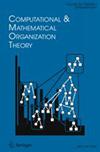How Relational Publics Become Scandal Audiences: Values and the construction of scandal
IF 1.5
4区 管理学
Q3 COMPUTER SCIENCE, INTERDISCIPLINARY APPLICATIONS
Computational and Mathematical Organization Theory
Pub Date : 2023-07-01
DOI:10.1177/26317877231204085
引用次数: 0
Abstract
We are interested in examining the process of scandal creation through the lens of the audience. Extant work tends to address either the effects of organizational scandal, or the role of the media and social control agents in scandal creation, neglecting the audience. To address this gap, we draw on the sociological concept of the relational public to explore how individual or small group assessments become widely held social evaluations among scandal audiences. We develop a three-stage model of organizational scandal creation: first, scandal entrepreneurs and the media frame an organization’s behavior as transgressive to media consumers who react within the relational publics they constitute; next, members of those relational publics judge the act in light of their values; finally, as relational publics spread their judgment to adjacent groups, they aggregate and assemble into a scandal audience, activating the scandal. Our model adds to media-centered theories of scandal construction by highlighting the role of heterogeneous audiences and their values, building a nuanced understanding of the process of social evaluation in scandal creation.关系公众如何成为丑闻受众:价值观与丑闻建构
我们感兴趣的是通过观众的镜头来审视丑闻的产生过程。现有的研究倾向于要么解决组织丑闻的影响,要么解决媒体和社会控制代理人在丑闻产生中的作用,而忽视了受众。为了解决这一差距,我们利用关系公众的社会学概念来探索个人或小团体评估如何成为丑闻受众广泛持有的社会评估。我们建立了一个组织丑闻产生的三阶段模型:首先,丑闻企业家和媒体将组织的行为框架为违反媒体消费者的行为,媒体消费者在他们构成的关系公众中做出反应;其次,这些关系公众的成员根据他们的价值观来判断行为;最后,当关系公众将他们的判断传播给相邻群体时,他们聚集并聚集成丑闻观众,激活丑闻。我们的模型通过强调异质性受众及其价值观的作用,增加了以媒体为中心的丑闻建构理论,并对丑闻产生中的社会评价过程进行了细致入微的理解。
本文章由计算机程序翻译,如有差异,请以英文原文为准。
求助全文
约1分钟内获得全文
求助全文
来源期刊

Computational and Mathematical Organization Theory
COMPUTER SCIENCE, INTERDISCIPLINARY APPLICATIONS-MATHEMATICS, INTERDISCIPLINARY APPLICATIONS
CiteScore
3.80
自引率
16.70%
发文量
14
审稿时长
>12 weeks
期刊介绍:
Computational and Mathematical Organization Theory provides an international forum for interdisciplinary research that combines computation, organizations and society. The goal is to advance the state of science in formal reasoning, analysis, and system building drawing on and encouraging advances in areas at the confluence of social networks, artificial intelligence, complexity, machine learning, sociology, business, political science, economics, and operations research. The papers in this journal will lead to the development of newtheories that explain and predict the behaviour of complex adaptive systems, new computational models and technologies that are responsible to society, business, policy, and law, new methods for integrating data, computational models, analysis and visualization techniques.
Various types of papers and underlying research are welcome. Papers presenting, validating, or applying models and/or computational techniques, new algorithms, dynamic metrics for networks and complex systems and papers comparing, contrasting and docking computational models are strongly encouraged. Both applied and theoretical work is strongly encouraged. The editors encourage theoretical research on fundamental principles of social behaviour such as coordination, cooperation, evolution, and destabilization. The editors encourage applied research representing actual organizational or policy problems that can be addressed using computational tools. Work related to fundamental concepts, corporate, military or intelligence issues are welcome.
 求助内容:
求助内容: 应助结果提醒方式:
应助结果提醒方式:


